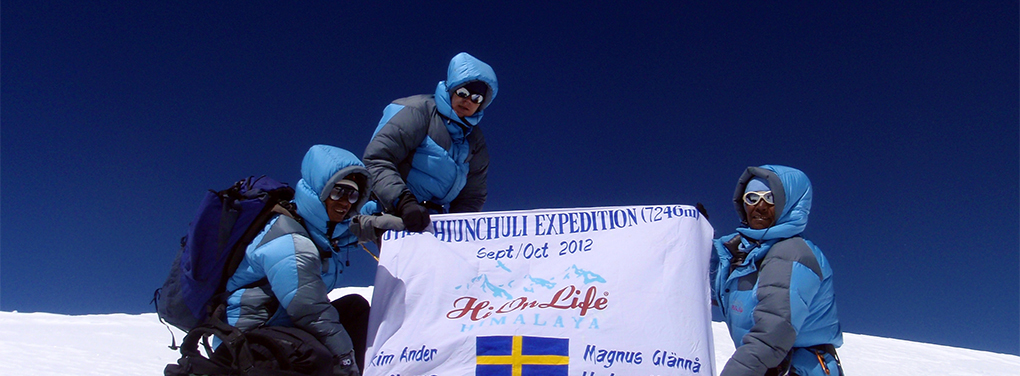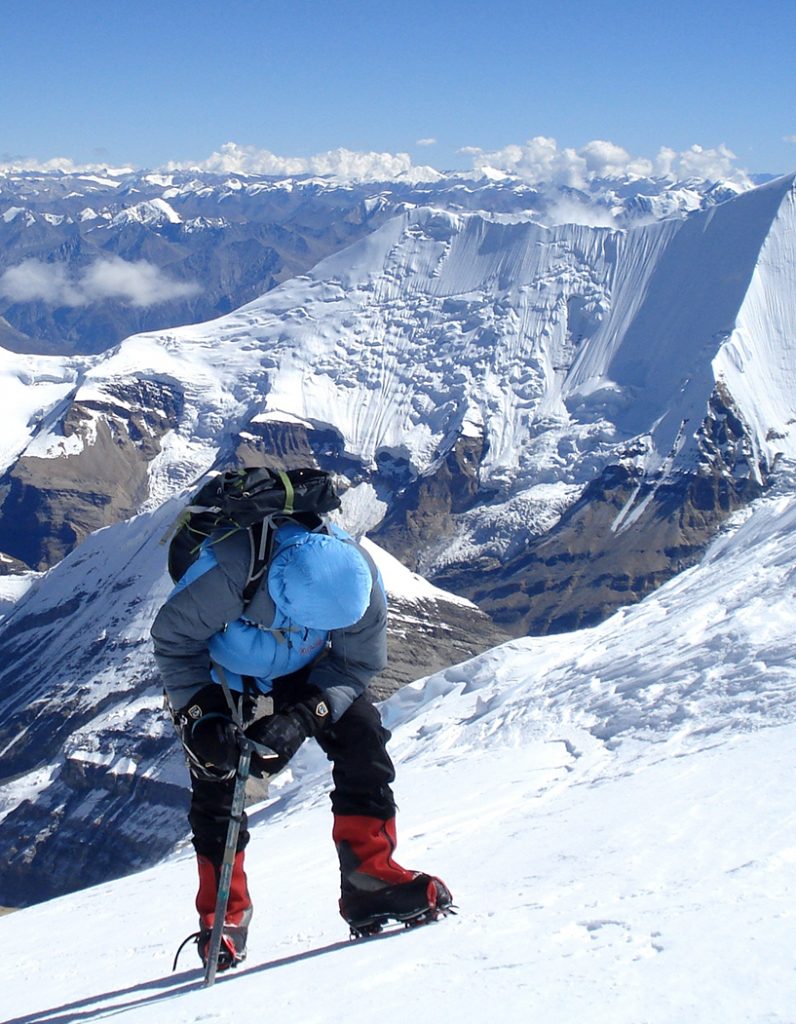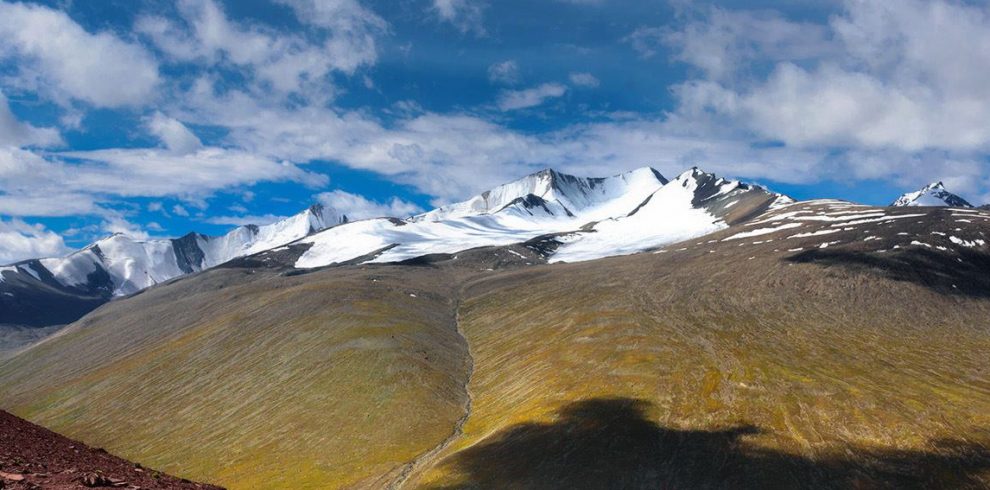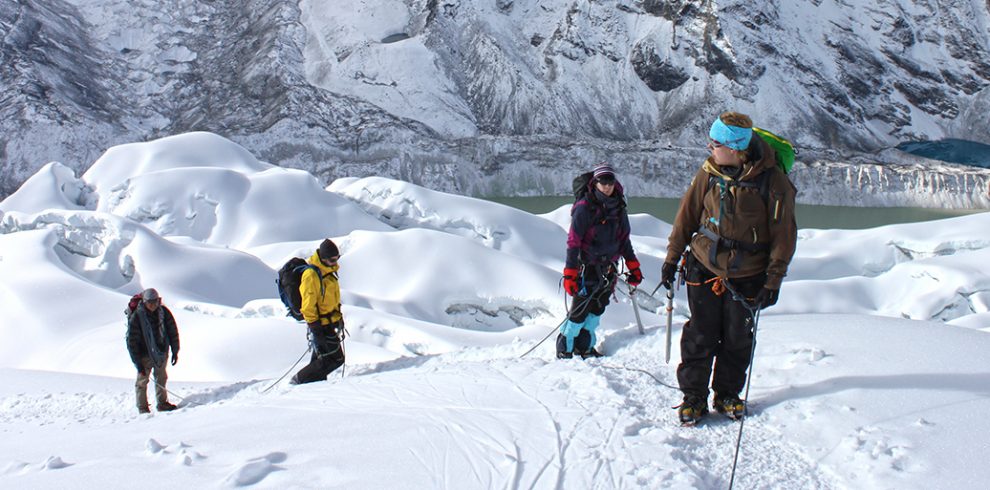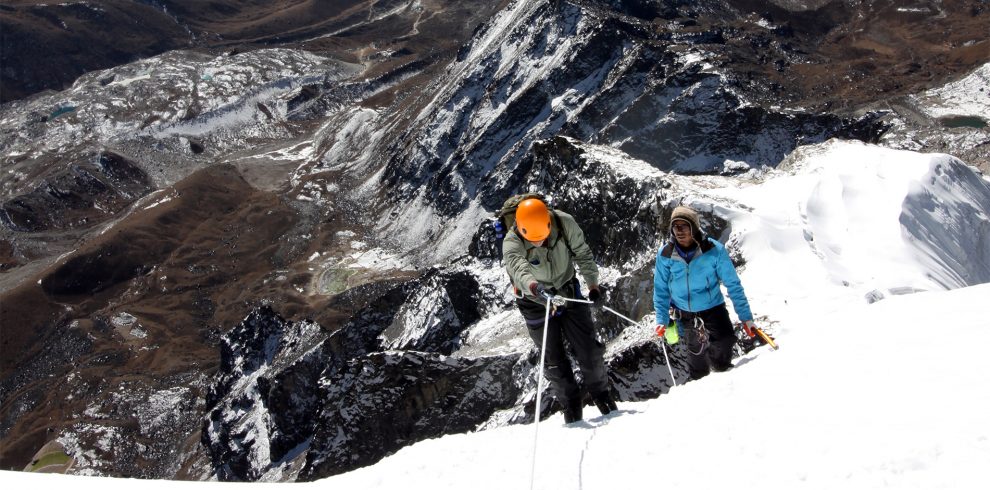Mt. Putha Hiunchuli, also known as Mt. Dhaulagiri VII at 7246 m, is the western most peak of Dhaulagiri range and is the last 7000 m mountain marking the end of the snow-capped range. This mountain was first climbed in 1954 by Jimmy Roberts, a legendary explorer, and climber.
Hi On Life Adventures have been looking for a relatively easier and safer 7000 m mountain in Nepal, hence we introduce Mt. Putha Hiunchuli, for those who want to climb high mountains without much technical difficulty and avalanche dangers. Moreover, for those adrenaline freaks out there, you can add more exhilaration to your climb by skiing down this mountain, as it provides a good slope to ski down.
Unlike most parts of Nepal which are thronged by thousands of tourists, not many people know about this mountain and its region, thus providing you the chance to explore its uniqueness. Even the approach to this mountain is enchanting and mesmerizing as we walk through high cliffs, deep canyons and breathtaking valleys of the famous but relatively less explored and restricted area of Nepal, called the Dolpa.
Overview
Although it is a relatively easier mountain to climb, Mt. Putha Hiunchuli is still a 7000 m+ mountain and nevertheless, it should be taken seriously and with utmost preparation. A very high level of physical fitness is required as it involves endurance climb at very high altitude and extremely low temperatures. Temperatures on summit day could be as low as -40 degrees Celsius.
Mt. Putha Hiunchuli Expedition involves roped-up glacier climbing with crevasse crossings. The snow slopes are up to 40 degrees. We use fixed ropes on steeper sections of the climb, but much of the climbing will be done as roped teams. Although our Sherpa team will establish the camps on the mountain and carry food and fuel, we expect our team members to carry their own gear. We have set aside two weeks for the climbing period, which allows you to acclimatize and prepare for the summit. We plan to use three camps above base camp – Camp 1 at 5,400m, Camp 2 at 6,200m and Camp 3 at 6,600m.
What makes this expedition special
- This is a technically easy 7,000m peak with a straight forward climb
- There are few objective dangers compared to other popular 7,000m mountains
- Explore the restricted and the most remote part of the Himalaya- Dolpo
- The mountain is excellent preparation for Everest or another 8,000m peak
- Extraordinary experience of wilderness expedition for those looking for adventure in the truest form
Itinerary
Once you reach KTM airport and finish with the immigration and custom formalities be prepared to confront the confusion outside the airport which is common in most of the south Asian countries. As you walk out of the Exit door into the passenger pick up area you will see hundreds of people with different sign boards in their hands, taxi drivers looking for fares, hotel touts looking for customers and porters trying to help with the luggage for tips. Please remain calm and do not walk out of the restricted area into the crowd straight away. Remain there and try to find the Hi On Life’s sign board. Once you spot it, walk straight to the signboard and identify yourself. From here we will take care of you.
When you arrive to your hotel you will be briefed about your activities and “do’s and don’ts” while your stay in Kathmandu. We will also collect some documents from you. Please have the following things handy when arriving.
Travel/ Medical Insurance (photo copy)
3 passport size photos
Photocopy of your passport.
In the evening we will go for a traditional Nepali dinner at Kathmandu’s finest Nepali restaurant to end the day.
After breakfast you will be taken for a half day city tour where you will be visiting some historical temples and monuments. You will end your sightseeing with a lunch. After your lunch you will visit the Department of Tourism to meet the Government official for a formal briefing. You will then return to your hotel and your Expedition Leader will give you your briefing and issue you your ‘trek pack’ consisting of a duffle bag, down jacket, sleeping bag, inner liner for your sleeping bag and rain poncho. Your afternoon is free for you to do your packing and purchasing your last minute items for your expedition.
Flight: 1 hour
From Kathmandu airport we fly to Nepalgunj which should take about an hour. Nepalgunj is a on the Terai plains near the southern border with India. It is an important junction to connect all of Western Nepal, being the gateway to far West mountainous regions like Dolpo and Jumla and also to Bardia National park which is famous for Jungle Safari tours to see tigers.
Upon arrival to Nepalgunj, we will check in to our hotel. You can expect a temperature bet 32C to 38C. There is a swimming pool at the hotel, therefore do not forget to bring your swimming contume to chill out at the pool.
Overnight hotel
Flight: 40 mins
Drive: 1 ½ hours
Early morning flight in a small twin otter plane will take us to Juphal which is a small airport that connects the region of Dolpo with rest of Nepal. Once we land at Dolpo we will be asked to make entries of our passports since this is a restricted area. We will walk past the airport and the village and take a jeep to Dunai.
Overnight hotel.
Dunai is a small bustling town which is former Village Development Committee that is now part of Thuli Bheri Municipality in Nepal. Dunai is also the district headquarters of Dolpa District.
Trek: 6 hours
The trail is easy and we follow the Bheri river all the way to Tarakot. It is a very gradual ascent without any major ascends or descends.
Tarakot is a small village with a police checkpost and a few houses.
Overnight camping
Trek: 7 hours
Today the trail involves a few ascends and descends. Overall the trek is moderate and most of it is through forests.
Overnight camping
Trek: 6 hours
The trail is undulating for about 2 hours after which we start to climb gradually. The trek is moderate with small ascents and descents and extremely scenic. Before reaching Kakkot we walk past a narrow staircase with a vertical drop to the river. The trail is too narrow for our mules, therefore they cross the river further down if the river is not too high.
Overnight camping
Kakkot is a charming little village with its own unique governance. All the mules that we have brought from Dunai will be sent back as the people from Kakkot does not allow outsiders to work inside their area. They usually require 2 days to bring down their Yaks form the mountains and getting ready to go on the expedition to Base Camp. The will re weigh all the gears that we had brought and re pack. Then they draw lots among the villagers to decide who gets the jobs.
While the villagers are busy with collecting their yaks and drawing lots for job, we will utilise these two days for acclimatization. We have a tough day the day after.
Trek: 8 hours
We cross the river to the other side of the village and straight away begin to climb a steep side of the mountain. There is no trail so we make switchbacks to ascend to the top of the ridge. We take a short break for lunch here. After the pass the trail climbs through narrow rocky ridge and then walks on top of the ridge for about half an hour. At this point we have made about 1500m elevation gain, therefore it is normal to feel a tired and even have some headache. After the ridge we descend down to a flat meadow which is at an elevation of about 4500m.
Overnight camping
Trek: 4 hours
The trail is along the side of the mountain without much ascents or descents but there are narrow sections and landslide crossings involved. We reach Base Camp by lunch time.
The rest of the day is to arrange your tents and unpack the climbing gears that had been carried separately during the trek.
Overnight camping
We will utilize these couple of days for training and safety instructions. We will also hike half way up to Camp 1 for acclimatization.
You can arrange your climbing gears and set aside your personal high altitude food and supplies that you need in the mountain. These will be carried by our porters to Camp 1.
Overnight camping
Trek: 4 hours
We will leave Base Camp and trek through the glacier to Camp 1. Camp one is on a rocky moraine of the glacier that comes down from Putha Hiunchuli and the adjacent mountains. Camp 1 will be our Advanced Base Camp until the climb is over. We will also have a small kitchen tent at Camp 1.
Overnight Camp
Camp 1 to Camp 2: The route to Camp 2 (6400m) involves some loose rocks and boulder climb to the top of the rocky plateau. This first part can be rough as it is not comfortable to climb through boulders with mountaineering boots. After the plateau it is fairly easy route on rock slabs to the bottom of the glacier. From here we use fixed rope for about 200m, after which it is an easy ascent for another 150 m to Camp 2.
Camp 2 to Camp 3: The route to Camp 3 involves a gentle climb across the glacier. There are a few crevasses that are visible, but sometimes covered by snow, so we are attached to the main rope. Camp 3 is on a small flattish ledge below the main slop leading to the summit.
Camp 3 to Summit: The route is fairly easy and straightforward all the way to the ridge and then a short gentle climb to the Summit.
The entire climb from Camp 1 to the Summit is fairly straightforward and rarely involves any inclinations more than 40 degrees. We will make acclimatization hikes to Camp 2 and Camp 3 and wait for the weather window for our final summit push.
Above Camp 1 we will be providing freeze dried food, canned food, biscuits and chocolates, dried meat and cheese and soup. We recommend you to bring a few packets of your favourite snack. There will be 2 people sharing a tent.
Trek: 8 hours
We trek back to Kakkot the same way as we had come up but skip the interim camp, therefore it is a tiring 8 hours descend, but worth it since we will be longing to get back to lower elevation and warmer place.
We will trek the same way back to Juphal making night stops at Khanigaon, Tarakot and Dunai. From Dunai we take a jeep back to Juphal.
Juphal to Nepalgunj flights are in the morning and we get a connection flight from Nepalgunj to Kathmandu in the afternoon.
Final Departure/ Fly home
Cost Includes
- 4 nights at Hotel Tibet in KTM on B/B – Twin Sharing Room
- 1 night hotel in Nepalgunj including all meals.
- Expedition Permit Fee, Government Liaison Officer
- National Park fee, TIMS permit fees
- Flight: Ktm-Nepalgunj & Nepalgunj-Juphal.
- Flight back: Juphal-Nepalgunj-Kathmandu.
- 1 High Altitude Climbing Sherpa for 2 members.
- 1 Base Camp Cook, and Kitchen Helper
- Porters and yaks to carry equipment, food/fuel.
- All Nepali staffs Insurance/ wages and equipment allowance
- 40 kgs per member for personal baggage
- All meals while camping.
- Single tent at Base Camp. Twin share tent on the trek and above Base Camp.
- All tents including Dinning/Kitchen/Toilet/Store Tent, Hot Shower Tent.
- 1 Gas Heater for Base Camp
- Primus Ep gas, burners, cooking pots for Higher Camps.
- Bottled oxygen with mask & Regulator for Medical Use
- All necessary Climbing route equipments
Cost Excludes
- Insurance: Travel/Accident/Medical /emergency evacuation
- Private room accommodation in Kathmandu unless a single supplement is paid.
- Staff tipping
- Nepal entry Visa
- Telephone, laundry, mineral water, soft drinks and alcoholic beverages.
- Emergency rescue evacuation cost if needed
- All other personal nature expenses.
Map
Nepal, a tiny country, nestled in the Himalayas between India and China, is one of the most diverse and fascinating countries in the world. Covering an area of only 147,181 sq. km, Nepal encompasses the world’s highest mountains and the deepest valleys as well as low elevation rain forest. Although the width of the country is only 200Km North to South, Nepal has the highest altitude variation of any country on earth, from 20m above sea level to 8848m above sea level (Top of Everest). The country is divided in to 3 elevation Zones viz. the low Terrain, the Midhill region and the High Himalayas, which contains 1/3 of the Himalayan range with 9 of the world’s highest mountains. This wide diversity of landform gives Nepal an incredible wealth of flora and fauna. Nepal is not only famous for its landscape but also renowned for the friendliness of its people. The people of Nepal are as variable and intriguing as the country’s geography. There are more than 37 ethnic groups with their own language and culture. Hinduism is the official religion, which the majority of the people practice. Many people throughout the country are Buddhist and the two religions have co-existed in harmony over the ages. A small number of people practice Christianity and Islam.
Nepal at a glance:
Longitude: 26’12’ and 30’27’ No Latitude: 80 degree 4′ and 88 degree 12′ East
Population: 24 million
Capital: Kathmandu
Area: 147,181 sq. km.
Program detail:
We begin our expedition with a scenic mountain flight from Kathmandu to Nepalgunj and to Juphal. We will trek through the exotic valley of the restricted area of Dolpo. From a village called Kakkot there are no more villages, therefore our expedition actually starts from this village. After acclimatizing and preparing for a few days in this village we set off on to a two day trek to Base Camp. Putha Hiunchuli Base Camp (4900m) is on a beautiful grassy meadow. We climb from the North side of this mountain. The guides and Sherpas will fix rope on the route and stock the camps with provisions and equipment. We will begin our ascent progressing towards Camp I, Camp II, Camp III and make a bid for the summit.
Guides and Sherpas will carry all group gear but members are expected to carry their own personal gear.
Radios and Satellite phones will be used to co-ordinate between the climbers and the Sherpas and Base Camp to provide a safety back-up if necessary.
The Climb:
Hi On Life Adventures emphasizes on safety and at the same time help as many team members as possible reach their goal.
We ensure a cautious climbing, with excellent leadership, organization and Sherpa climbers support. We provide the best equipment available along with an excellent logistic and technical support providing `walkie-talkie` radios, satellite telephones, cooks and kitchen staff, healthy food, medical oxygen, gamow bag, extensive medical kit, top quality climbing accessories etc. that all trekkers/ climbers who has ever been on any of our Hi On Life treks/ expeditions are well versed with.
On the Mountain: We have highly experienced Climbing Sherpas, and we provide one climbing Sherpa between two climbers. Our Sherpas will fix the route, set up the higher camps, as well as carry the group equipment, such as tents, stoves, food etc. They also help with high altitude equipment transport, carrying your extra weight both up and down the mountain. You do not need to carry a heavy rucksack during the climb.
For an additional expense, we can also provide personal Sherpa and climbing-guides to individual members who wish to have their own private Sherpa.
Cooks and Food: Our skillful and hard working cooks prepare three hot meals each day with a very healthy diet of fresh vegetables, cheeses, eggs, and fresh meat as well, tinned fruits, tinned meats and fish (all meats and fish are prepared separately out of respect for the vegetarians in our midst) and a high dose of carbohydrates from breads, rice and pastas. We have weatherproof kitchens and heated dining tents, with comfortable chairs and tables.
Please note: Any ascent of a Himalayan peak must be taken seriously. The Group leader will take all factors concerning group fitness and acclimatization, weather and snow condition into consideration when making a decision. While recognizing that this ascent is important to the group, first priority will always be safety. The decision on whether or not you will be able to attempt Putha Hiunchuli rest with the Group Leader. His/ her decision is final and must be accepted.
A Day on Your Trek
Although each day is different, considering the weather, general pace of the group and length of the days walk, in general your day begins with a wake up tea at around 6 to 6:30 in the morning. You will then be provided with a bowl of warm water for washing. Then you will need to pack your duffel bag and your day pack and come to the lodge’s dining for breakfast.
After breakfast we will hit the trail and usually walk for about 3 to 4 hours before we stop for lunch. We will give you about an hour and a half rest during lunch, which will also give enough time for the staff to have their lunch and pack. Usually after 3 to 4 hours of walking we finish the days walk by 4 PM. Tea/ Coffee and snacks will be served on arrival to the lodge. Your group Leader will often organize side trips in the afternoon. Your dinner will be served around 7 PM.
During camping at Base Camps: You will be sleeping in Tents and the food will be cooked and served in the dining tent by our staff. We will provide single tent with comfortable sleeping 3 inch foam mattress with insulated ridge mattress at base Camp. On higher camps we provide North Face VE 25 tents on twin sharing. We also have weather proof Kitchen and Dining tents with comfortable tables and chairs. Toilet tents with sitting pot and shower tent will be provided at Base Camp.
High Altitude
On this expedition you will be climbing a technical mountain which is 7135m, so it is very important to understand the effects of altitude. The greatest provocation is going too high too fast. Hi On Life’s itinerary has been carefully designed to minimize the effects of altitude. We ascend slowly and surely allowing enough time for safe acclimatization.
Headaches and breathlessness are common at altitude which in itself is nothing to worry about. In rare cases, this may worsen to Acute Mountain sickness (AMS), so a close watch is kept on all trekkers by the group leader who is trained to recognize the symptoms of AMS which are severe headaches, nausea, lethargy, loss of appetite serious breathlessness even at rest. If any trekkers show such signs they will be descended to relatively lower and safer altitude. The Group Leader’s decision on evacuating such person to a safe altitude is final. Do not medicate yourself without first informing your group leader. Going to altitude slowly with adequate rest and adequate intake of fluid (3 to 4 litres per day), you will most likely have no problems apart from breathlessness on hills which is completely normal as the percentage of Oxygen in the air is relatively lower to that at sea level. The most important thing is not to worry about altitude because our team is there to take care of you.
Staff
Group leader: Our Group leaders are highly trained in all aspects of the trek, conservation, first aid specializing on altitude sickness, emergency procedures and have extensive knowledge of the natural history of the area.
Sirdar: His job is to manage and organize staff duties. He is responsible for the actual operation of the trek.
Climbing Sherpas: They are the key to a successful summit. They fix ropes and fix routes up the mountain. They will also carry your sleeping bags, tents and cook high altitude food up in higher camps in the mountain.
Cook: Responsible for your food. Hygiene of a high standard is taken into consideration in preparing the food.
Climbing Sherpas: Climbing Sherpas will ferry load up the mountain and establish camps. They will also fix ropes on sections where we require fixed lines and accompany you while climbing up to the summit.
Mules and horses: to ferry expedition gears to Base Camp.
Weather:
June till September
On the trek at lower altitude (3500m to 4500m) during daytime the Max temp can be around 15C to 20C and the Min temp can be 0C to 5C
During the climb: Daytime Max temp can be between 5C to 10C and Min temp can be between -8C to -15C
On your summit day: You can expect between -15C to -20C + wind chill factor depending on the wind speed
Please note that this is just general information and it could vary.
Recommendations for things you should bring:
Clothing:
Head
- Warm hat wool or synthetic that covers your ears
- Balaclava
- Sunhat
- Glacier sunglasses with side shields, 1 pair ski goggles (optional)
- Headlamp with extra batteries and bulbs
- Bandana or head scarf, also useful for dusty conditions
- 2 cotton t-shirts
- 2 polypropylene t-shirt
- 2-3 long sleeve thermal underwear shirts, lightweight
- 2 heavy thermal underwear
- 1 polar fleece jacket
- Gore-Tex jacket with hood, waterproof and breathable
Please note: We provide 1 very warm goose-down (duvet) jacket with hood. However, you can bring your own if you already have it.
- 1 pr. lightweight poly-liner gloves
- 1 pair mittens, consists of 1 Gore-tex over mitt matched with the very warm polar Fleece mitt liner
- 1 pair down mittens
Lower Body
- 1 pair walking shorts
- 1 to 2 pair walking trousers for trekking and around camp
- 2 pair lightweight thermal bottoms
- 2 pair heavy or expedition weight thermal bottoms
- 1 pair polar fleece trousers
- 1 pair Gore-Tex trousers, Waterproof/breathable with side zips
- 1 pair climbing boot preferably for 7000m+ (you can also hire them in Kathmandu)
- 1 pair treking /walking boots with good ankle support
- 1 pair trainers, running shoes and/or sandals for Kathmandu and in camp;
- 1 pair down booties (optional)
- 2 pair heavy preferably wool socks
- 3 pair of liner socks. Polypropylene or wool
- 3 pair medium lightweight trekking socks, poly or wool
Sleeping
- For high altitude, 1 down (duvet) sleeping bag (rated to – 20 Centigrade or -0 F)
Please note: We provide Exped down matress and kari mats (You dont need to bring your own)
Rucksack and Travel Bags
- 1 medium rucksack (50-70 litres)
- Small padlocks for duffel kit bags.
Please note: We provide you 2 big duffle bags.
Personal Food for camps beyond Advanced Base Camp.
We ask each member to bring their own imported daily snack and energy foods for higher camps. We recommend you to bring 8 to 10 packets of Turmat or equivalent quality freeze dried food of your choice of flavours. In addition, growing variety of imported foods such as cheeses, chocolates, biscuits, cookies, nuts, and power-bars are now available in Kathmandu, at realistic prices.
Accessories
- 1 small roll of repair tape, 1 sewing repair kit
- 1 cigarette lighter
- 1 compass or GPS
- Camera
- Nylon stuff sacks for food and gear storage, large Ziplocs are useful also
- 3 Water bottles (1 litre)
- 1 plastic cup and spoon
- 1 small folding knife
- Books, playing cards, ipod/mp3 player, games, musical instrument etc
- Adequate amount of batteries, etc.
Healthy and trouble free holiday
There are no compulsory vaccinations required for entering Nepal. However please consult a doctor for vaccination against Typhoid, Meningitis, polio, and hepatitis. If you have special dietary requirements or allergies, please through your agent, give us a list of what you can
and can’t eat so that we can provide proper food for you.
If you are undergoing a course of prescription medicine, please ensure that you have sufficient supplies for the entire holiday. Some types of drugs including antimalarials have side affects at high altitude; therefore please consult your doctors regarding these drugs. The places you trek are mosquito free and there has been no report on malaria in Kathmandu for the past couple of decades.
Insure yourself:
Insure yourself
Hi On Life Adventures strictly follow the policy, No Insurance= No expedition! We highly recommend you to take a comprehensive Personal Travel Insurance with Rescue before leaving home. It is mandatory that your insurace covers helicopter evacuation, even above 6000 m and incase of unforeseen incident they should cover long line re
Money Matters
The ideal currency to bring with you is US$ or Euro. There are Atm machines in Kathmandu and Namche Bazaar where you can draw money as per your bank limit.
In Kathmandu: Each meal will cost around 4 to 6 US$. Plus 10 to 20 US $ for your taxis if you wish to go around the city.
On trek: you will need around 5 to 6 US $ per day. This money is for your hot showers, chocolates, soft drinks and beers etc and also for small donations in the monasteries.
Tipping
Although tipping is entirely optional and personal matter the following is recommended as a guideline
In Kathmandu: for bellboys, waiters and porters 50 to 100 Nepali Rupees
On the trek: At the end of the trek it is a customary to tip the field staff. The recommended amount is 200 to 250 US$ / member. The Expedition leader will organize that for you.
Please Note: Climbing Sherpa Bonus is extra which is 500 USD/ member as a summit bonus.
Some Do’s and Don’ts
Nepalese people treat visitors as special guests. Although they will never rebuke you publicly for unknowingly offending them, we must consider their culture.
While in Nepal please observe the following:
- Full or partial nudity is not accepted.
- Over display of affection between men and women, especially in temples and monasteries are discouraged.
- Please remove your shoes before entering monasteries and temples.
- Never point the soles of your feet at a person or shrine.
- Many Hindu temples are closed to non-Hindus. Please ask before entering.
- Locals walk around the Mani walls and Stupas in a clockwise direction as a respect and they expect you to do the same although it is not compulsory.
“TODAY IS YOUR DAY! YOUR MOUNTAIN IS WAITING, SO… GET ON YOUR WAY!”
DR. SEUSS

